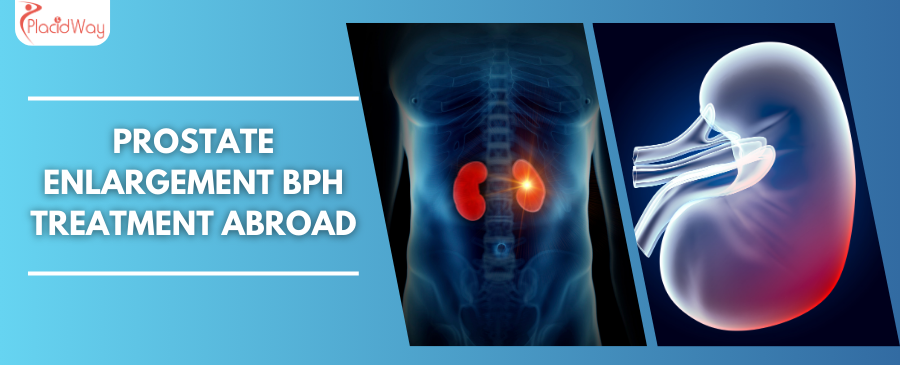
Finding Lasting Relief from Prostate Enlargement (BPH): Your Treatment Options
Facing the daily challenges of an enlarged prostate, also known as Benign Prostatic Hyperplasia (BPH), can significantly impact your quality of life. The constant urge to urinate, a weak stream, or frequent nighttime bathroom trips are not just inconveniences; they can be signs of a condition that requires attention. If you're searching for "enlarged prostate symptoms" or "what to do for enlarged prostate," you're not alone. Millions of men worldwide experience BPH, and thankfully, modern medicine offers numerous effective solutions.
This guide will walk you through everything you need to know about prostate enlargement, from understanding its causes and identifying symptoms to exploring the latest treatment options. We'll also delve into why many patients are choosing medical tourism for BPH treatment, offering insights into global costs, top destinations, and how to ensure a safe, high-quality experience abroad. Our goal is to empower you with information, helping you make an informed decision on your journey to lasting relief.
What are the common symptoms of an enlarged prostate (BPH)?
If you've found yourself searching for "difficulty peeing male" or "waking up at night to urinate," you're likely experiencing some of the hallmark symptoms of BPH. As the prostate gland grows, it can press on the urethra, the tube that carries urine from the bladder out of the body, leading to a range of bothersome urinary symptoms. These can include:
- Frequent or urgent need to urinate: This often means going to the bathroom more often, even shortly after you've just gone.
- Increased frequency of urination at night (nocturia): Disrupting sleep repeatedly to use the toilet.
- Difficulty starting urination (hesitancy): A delay in initiating the urine stream.
- Weak or intermittent urine stream: The flow of urine may stop and start, or lack force.
- Dribbling at the end of urination: A few drops of urine escaping after you think you're done.
- Inability to completely empty the bladder: Feeling like there's still urine left, which can lead to complications.
- Straining during urination: Having to push to get urine out.
While these symptoms are commonly associated with BPH, it's crucial to consult a doctor to rule out other conditions like prostate cancer or bladder issues. Early diagnosis and treatment can prevent more severe complications.
What causes prostate enlargement (BPH) and who is at risk?
Many men wonder, "Why does my prostate get big?" The exact cause of prostate enlargement (BPH) isn't fully understood, but it's strongly linked to the natural aging process and changes in hormone levels. As men age, the cells in the prostate gland begin to multiply, leading to its gradual enlargement. Key factors and risk groups include:
- Aging: This is the primary risk factor. BPH rarely causes symptoms before age 40, but by age 60, about one-third of men experience moderate to severe symptoms, increasing to over half by age 80.
- Hormonal Changes: An imbalance of hormones, particularly testosterone and dihydrotestosterone (DHT), plays a significant role in prostate growth.
- Family History: If close relatives (father or brother) have BPH, you're more likely to develop it.
- Medical Conditions: Obesity, heart disease, and type 2 diabetes have all been linked to a higher risk of BPH.
- Lifestyle: Lack of physical activity can increase risk, while regular exercise may offer some protection.
Understanding these "causes of BPH" and "risk factors for enlarged prostate" can help you have a more informed discussion with your healthcare provider about prevention and early detection.
What are the effective treatment options for prostate enlargement (BPH)?
When you're searching for "BPH treatment options" or "minimally invasive BPH procedures," you'll find a spectrum of choices, from conservative management to advanced surgical interventions. The best approach depends on your symptoms, prostate size, overall health, and personal preferences.
Watchful Waiting/Lifestyle Changes
For mild symptoms, your doctor might recommend "watchful waiting," combined with lifestyle modifications such as reducing fluid intake before bed, avoiding caffeine and alcohol, and timed voiding.
Medications
Common pharmaceutical interventions include:
- Alpha-blockers: Relax bladder neck muscles and prostate muscle fibers to make urination easier (e.g., Tamsulosin, Silodosin).
- 5-alpha reductase inhibitors: Shrink the prostate by blocking the production of hormones involved in prostate growth (e.g., Finasteride, Dutasteride).
- Combination therapy: Often, both types of medications are prescribed together for better results.
Minimally Invasive Procedures
These are popular "TURP alternatives" offering faster recovery and fewer side effects than traditional surgery:
- UroLift System: Uses small implants to lift and hold the enlarged prostate tissue away from the urethra, opening the channel. It preserves sexual function and offers quick symptom relief.
- Rez?m Water Vapor Therapy: Uses natural water vapor to destroy excess prostate tissue, leading to prostate shrinkage and symptom relief over time. Also known for preserving sexual function.
- Aquablation Therapy: A robot-assisted procedure that uses a high-velocity water jet to precisely remove prostate tissue. Effective for larger prostates.
- Prostatic Artery Embolization (PAE): A non-surgical procedure where tiny particles are injected into arteries supplying the prostate, blocking blood flow and causing the prostate to shrink.
Surgical Options
For severe symptoms or larger prostates, surgical options include:
- Transurethral Resection of the Prostate (TURP): The most common surgical procedure for BPH, involving the removal of excess prostate tissue through the urethra. Highly effective, but carries a higher risk of side effects like retrograde ejaculation.
- Laser Surgery: Uses high-energy lasers to vaporize or cut away excess prostate tissue (e.g., Holmium Laser Enucleation of the Prostate (HoLEP), Photoselective Vaporization of the Prostate (PVP)).
- Open Prostatectomy: Reserved for very large prostates or complex cases, involving an incision to remove prostate tissue.
Each option has its own benefits, risks, and recovery profile. Your urologist will help determine the "best BPH treatment" for your specific situation.
Who is an ideal candidate for BPH treatment?
The question "When should I treat an enlarged prostate?" often arises when symptoms become more than just an annoyance. Generally, you're an ideal candidate for BPH treatment if:
- You experience moderate to severe BPH symptoms that affect your quality of life (e.g., frequent nighttime awakenings, inability to empty your bladder, recurrent UTIs).
- Medications have not provided sufficient relief or have caused unacceptable side effects.
- You have BPH-related complications such as urinary tract infections, bladder stones, kidney damage, or an inability to urinate (acute urinary retention).
- You are healthy enough to undergo a procedure, whether it's minimally invasive or surgical.
Factors like prostate size, your desire to preserve sexual function, and your overall health will influence the choice between various "who qualifies for BPH surgery" options. For example, smaller prostates might be better suited for UroLift or Rez?m, while larger glands may require Aquablation or HoLEP.
What can I expect during recovery after BPH treatment?
Understanding "BPH surgery recovery" is crucial for planning your treatment and return to daily life. The recovery period differs significantly based on the type of procedure:
- Minimally Invasive Procedures (UroLift, Rez?m, PAE):
- Hospital Stay: Often outpatient or a single overnight stay.
- Initial Discomfort: Mild burning during urination, urgency, or pelvic discomfort for a few days to a couple of weeks.
- Catheter: May be needed for a few days post-Rez?m, less common with UroLift or PAE.
- Return to Activities: Most patients resume light activities within a few days and full activities within 1-2 weeks.
- Symptom Improvement: Gradual, often noticeable within weeks to months as the prostate heals and shrinks.
- Surgical Procedures (TURP, HoLEP, Aquablation):
- Hospital Stay: Typically 1-3 days.
- Catheter: Usually required for a few days to a week after discharge.
- Initial Discomfort: More pronounced burning, urgency, and blood in urine for several weeks.
- Return to Activities: Light activities after 1-2 weeks; strenuous activities, heavy lifting, and sexual activity often restricted for 4-6 weeks.
- Symptom Improvement: Generally quicker and more dramatic than minimally invasive options, often within weeks.
Following post-operative instructions carefully, staying hydrated, and avoiding strenuous activities are key to a smooth "life after UroLift" or any other BPH procedure. Discuss specific recovery expectations with your surgeon.
What are the potential risks and side effects of BPH procedures?
Like any medical intervention, "BPH treatment risks" are a consideration. While generally safe, it's important to be aware of potential side effects and complications, which vary by procedure:
- Temporary Urinary Symptoms: Burning, urgency, and frequent urination are common in the weeks following most procedures, gradually improving.
- Bleeding: Some blood in the urine is normal post-procedure, but significant or prolonged bleeding requires medical attention.
- Infection: Urinary tract infections are a risk after any procedure involving the urinary system.
- Retrograde Ejaculation: This is a common side effect of some BPH treatments, particularly TURP, where semen goes backward into the bladder during orgasm instead of out through the penis. It's not harmful but can affect fertility. Minimally invasive procedures like UroLift and Rez?m often aim to preserve sexual function and reduce the risk of retrograde ejaculation.
- Erectile Dysfunction (ED): While less common, especially with newer minimally invasive techniques, ED is a potential risk, particularly with more invasive surgeries.
- Urinary Incontinence: Rare, but persistent leakage of urine can occur.
- Urethral Stricture: Scar tissue forming in the urethra, potentially narrowing it, can sometimes occur after procedures that involve instrumentation through the urethra.
Your doctor will discuss these "side effects of TURP" or "UroLift complications" in detail, helping you weigh the benefits against the risks for your chosen treatment path.
How much does prostate enlargement (BPH) treatment cost globally?
The "cost of BPH treatment" is a significant factor for many patients, especially when considering advanced procedures that may not be fully covered by insurance in their home country. Medical tourism offers a compelling solution, providing access to "affordable prostate surgery" without compromising on quality.
Estimated Cost Comparison Table (USD)
| Procedure | USA / Western Europe | Mexico / Costa Rica | Turkey / India / Thailand |
|---|---|---|---|
| UroLift System | $10,000 - $20,000+ | $6,000 - $12,000 | $5,000 - $10,000 |
| Rez?m Water Vapor Therapy | $9,000 - $18,000+ | $5,500 - $11,000 | $4,500 - $9,500 |
| TURP (Transurethral Resection of the Prostate) | $8,000 - $15,000+ | $4,000 - $8,000 | $3,000 - $7,000 |
| HoLEP (Holmium Laser Enucleation) | $12,000 - $25,000+ | $7,000 - $14,000 | $6,000 - $12,000 |
Note: These are estimated costs and can vary based on the clinic's reputation, the surgeon's experience, hospital stay duration, included pre/post-operative care, and currency exchange rates. They typically include the procedure, anesthesia, and basic hospital fees, but may not include travel, accommodation, or extensive post-op medications.
Why should I consider traveling abroad for BPH treatment?
Many individuals are increasingly looking into "medical tourism for BPH" for several compelling reasons:
- Significant Cost Savings: As seen in the table above, the cost of advanced BPH treatments like UroLift or Rez?m can be substantially lower in countries like Mexico, Turkey, India, or Thailand compared to the US or Western Europe. These savings often cover travel and accommodation.
- Access to Innovative Procedures: Some countries are at the forefront of medical technology, offering access to the latest BPH treatments and highly specialized urologists who perform these procedures routinely.
- Reduced Waiting Times: In some healthcare systems, waiting lists for elective surgeries can be long. Traveling abroad can mean receiving timely treatment without delays.
- High-Quality Care: Many international hospitals catering to medical tourists boast state-of-the-art facilities, internationally trained surgeons, and accreditations (like JCI) that rival top Western institutions.
- Privacy and Anonymity: For some, undergoing treatment away from home offers a greater sense of privacy.
- Recovery in a New Environment: The opportunity to recover in a pleasant, often tourist-friendly destination can enhance the overall patient experience.
The desire for "affordable prostate treatment" combined with high standards of care makes medical tourism an attractive option for many seeking relief from BPH.
Which countries offer high-quality, affordable BPH treatment for medical tourists?
When searching for "best countries for prostate surgery" or "top medical tourism destinations for urology," several nations consistently stand out for their blend of quality and affordability:
- Turkey: Known for its modern hospitals, skilled surgeons, and competitive pricing, particularly for HoLEP and other laser-based BPH treatments. Cities like Istanbul and Ankara have a strong medical tourism infrastructure.
- India: A powerhouse in medical tourism, offering world-class care at a fraction of Western costs. Many hospitals have dedicated urology departments equipped with the latest technology.
- Thailand: Renowned for its hospitality, excellent private hospitals, and highly trained medical staff. Bangkok is a hub for various minimally invasive BPH procedures.
- Mexico: Easily accessible for North American patients, Mexico provides affordable and quality BPH treatments, especially in cities like Tijuana, Cancun, and Monterrey, often with shorter travel times.
- Costa Rica: Offers a combination of quality medical care and a beautiful recovery environment, particularly appealing to those seeking a more holistic experience.
These countries often have internationally accredited hospitals (e.g., JCI accreditation), ensuring that safety and quality standards are met or exceeded.
How can I ensure a safe and successful medical tourism journey for BPH treatment?
Embarking on a medical journey abroad for BPH treatment requires careful planning to ensure a "safe BPH treatment overseas" experience. Here's what to consider:
- Research and Verify Hospital Accreditation: Look for international accreditations like Joint Commission International (JCI), which signifies adherence to global healthcare quality standards. Many reputable hospitals will proudly display these.
- Surgeon Credentials and Experience: Verify the urologist's qualifications, experience with your specific BPH procedure, and ask about their success rates. Many international doctors are trained in Western countries.
- Comprehensive Treatment Plans and Quotes: Request a detailed breakdown of what's included in the cost (procedure, anesthesia, hospital stay, medications, follow-ups). Ensure there are no hidden fees.
- Pre- and Post-Operative Care: Understand how your pre-operative evaluations will be handled and what post-operative care, including follow-up appointments and potential catheter removal, will entail. Discuss communication plans for any concerns once you return home.
- Language and Communication: Ensure the medical staff can communicate effectively in English or a language you understand. Many medical tourism-focused facilities have multilingual staff.
- Travel Logistics and Accommodation: Plan your travel, accommodation, and local transportation. Many medical tourism agencies can assist with these arrangements. Consider having a travel companion.
- Utilize a Medical Tourism Facilitator: Companies like PlacidWay specialize in connecting patients with reputable international clinics, handling logistics, and providing support throughout the process. They can help you compare "finding accredited hospitals abroad" and navigate the complexities.
- Emergency Planning: Understand the emergency protocols of your chosen hospital and have international travel insurance that covers medical emergencies.
By taking these steps, you can significantly enhance the safety and success of your "planning medical trip for BPH" and achieve the lasting relief you seek.
Take the Next Step with PlacidWay
Ready to explore treatment options abroad? Discover top clinics, compare prices, and get a free quote tailored to your needs with PlacidWay.
Urology Abroad | Best Urology Center





.png)
.jpg)
.png)
.jpg)

Share this listing